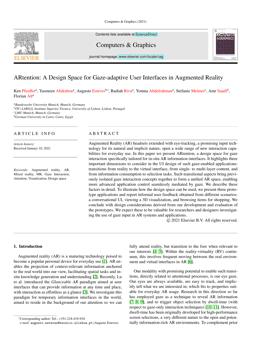ARtention: A Design Space for Gaze-adaptive User Interfaces in Augmented Reality
Augmented Reality (AR) headsets extended with eye-tracking, a promising input technology for its natural and implicit nature, open a wide range of new interaction capabilities for everyday use. In this paper we present ARtention, a design space for gaze interaction specifically tailored for in-situ AR information interfaces. It highlights three important dimensions to consider in the UI design of such gaze-enabled applications: transitions from reality to the virtual interface, from single- to multi-layer content, and from information consumption to selection tasks. Such transitional aspects bring previously isolated gaze interaction concepts together to form a unified AR space, enabling more advanced application control seamlessly mediated by gaze. We describe these factors in detail. To illustrate how the design space can be used, we present three prototype applications and report informal user feedback obtained from different scenarios: a conversational UI, viewing a 3D visualization, and browsing items for shopping. We conclude with design considerations derived from our development and evaluation of the prototypes. We expect these to be valuable for researchers and designers investigating the use of gaze input in AR systems and applications.
Publikation
 |
Ken Pfeuffer, Yasmeen Abdrabou, Augusto Esteves, Radiah Rivu, Yomna Abdelrahman, Stefanie Meitner, Amr Saadi und Florian Alt. ARtention: A Design Space for Gaze-adaptive User Interfaces in Augmented Reality. [Download Bibtex] |